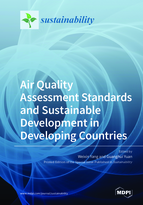Air Quality Assessment Standards and Sustainable Development in Developing Countries
A special issue of Sustainability (ISSN 2071-1050).
Deadline for manuscript submissions: closed (30 June 2019) | Viewed by 49072
Special Issue Editors
Interests: digital economy and finance; sustainable development
Special Issues, Collections and Topics in MDPI journals
Interests: system modeling; information economy; data mining; algorithm design
Special Issues, Collections and Topics in MDPI journals
Special Issue Information
Dear Colleagues,
Air pollution is a critical challenge faced by the world, especially in developing countries. During the rapid economic growth and remarkable pace of industrialization of typical developing countries, such as China and India, massive amounts of fossil fuels, including coal, petroleum, and natural gas, have been consumed. In addition to the traditional pollution from fossil fuels and sandstorm, fine atmospheric pollutants, such as PM2.5, PM10, and O3 continue to emerge and are compounded to create new hazards. Air pollution not only affects the public health and quality of life in developing countries, but also poses a threat to the sustainable development of their economy and society. How to quickly and efficiently control air pollution in developing countries has become a common concern in academia.
In order to scientifically measure and improve air quality, the U.S. established the Environmental Protection Agency (EPA) in the 1970s and published the first Pollution Standards Index. In 1999, the EPA added the measurement of daily average PM2.5 concentration into their PSI, which formed an independent Air Quality Index (AQI). After that, major developed countries constructed their own air quality assessment system respectively. The World Health Organization and various scientific research institutions have also established their air quality measurement standards with constant improvements. Based on that, the academies conducted in-depth studies on air quality measurement, and offered amendment suggestions to the current measurement indicator system.
Therefore, we organized this Special Issue to discuss the effectiveness of current air quality assessment standards in developing countries, the impact of air quality governance policies based on those standards, and how to improve those standards to effectively achieve sustainable development.
Submissions for this Special Issue could relate, but are not limited, to the following topics about developing countries:
- Spatial and temporal characteristics of air pollution and their impact on current air quality assessment standards
- The compatibility of current AQI standards and sustainable development
- The effectiveness of air pollution control policy based on current AQI standards
- The impact of air pollution control policy on sustainable development
- Multinational cooperative prevention and control of air pollution under existing air quality assessment standards
- How to improve current air quality assessment standards for promoting sustainable development
Prof. Dr. Weixin Yang
Prof. Dr. Guanghui Yuan
Guest Editors
Manuscript Submission Information
Manuscripts should be submitted online at www.mdpi.com by registering and logging in to this website. Once you are registered, click here to go to the submission form. Manuscripts can be submitted until the deadline. All submissions that pass pre-check are peer-reviewed. Accepted papers will be published continuously in the journal (as soon as accepted) and will be listed together on the special issue website. Research articles, review articles as well as short communications are invited. For planned papers, a title and short abstract (about 100 words) can be sent to the Editorial Office for announcement on this website.
Submitted manuscripts should not have been published previously, nor be under consideration for publication elsewhere (except conference proceedings papers). All manuscripts are thoroughly refereed through a single-blind peer-review process. A guide for authors and other relevant information for submission of manuscripts is available on the Instructions for Authors page. Sustainability is an international peer-reviewed open access semimonthly journal published by MDPI.
Please visit the Instructions for Authors page before submitting a manuscript. The Article Processing Charge (APC) for publication in this open access journal is 2400 CHF (Swiss Francs). Submitted papers should be well formatted and use good English. Authors may use MDPI's English editing service prior to publication or during author revisions.
Keywords
- Air pollution
- Air quality assessment standards
- Air Quality Index (AQI)
- Governance policies
- Sustainable development






